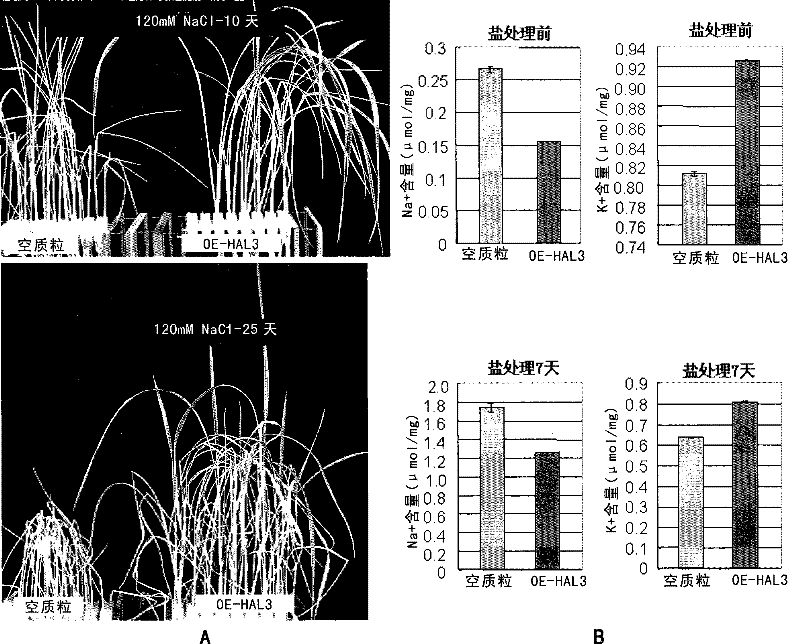Rice flavoprotein gene and use
A protein and rice technology, applied in application, genetic engineering, plant genetic improvement, etc.
- Summary
- Abstract
- Description
- Claims
- Application Information
AI Technical Summary
Problems solved by technology
Method used
Image
Examples
Embodiment 1
[0125] Example 1 Rice Flavoprotein Gene
[0126] It has been identified that the full-length ORF of the rice flavoprotein gene OsHAL3 is 663 nucleotides, encoding 220 amino acids, and its amino acid sequence is shown in SEQ ID NO: 2 or see figure 1 B; its nucleotide sequence is shown in SEQID NO: 1 or see figure 1 a.
Embodiment 2
[0127] Example 2 Effect of OsHAL3 gene on rice salt tolerance
[0128] The OsHAL3 gene was placed under the control of the CaMV35S promoter in the positive direction and constructed on the rice expression vector pHB; then, it was introduced into the rice variety "Zhonghua 11" by the Agrobacterium-mediated method.
[0129] Salt stress analysis of the positively transformed plants showed that the overexpression of the OsHAL3 gene led to a significant increase in the salt tolerance of the transgenic rice lines, which was due to the Na + ions drop significantly while the K + caused by a significant increase in ions, see figure 2 .
[0130] Depend on figure 2 A and figure 2 B shows that after 10 days of culture with 120mM NaCl, the growth of transgenic rice overexpressing OsHAL3 is basically normal, while the growth of transgenic rice with pHB empty plasmid is poor, and the leaves wither are more serious; after 25 days of cultivation, the transgenic rice overexpressing OsHAL...
Embodiment 3
[0132] Example 3 OsHAL3 gene improves rice seed storage tolerance
[0133] Although the seeds of the overexpressed OsHAL3 gene transgenic line were stored for 2 years, the seed germination rate was as high as 95%, while the germination rate of the transgenic rice or wild-type control seeds with the pHB empty plasmid was only 25%, see image 3 a.
[0134] This clearly shows that the OsHAL3 gene plays an important role in the storage tolerance of rice seeds, and has important application prospects.
PUM
 Login to View More
Login to View More Abstract
Description
Claims
Application Information
 Login to View More
Login to View More - R&D
- Intellectual Property
- Life Sciences
- Materials
- Tech Scout
- Unparalleled Data Quality
- Higher Quality Content
- 60% Fewer Hallucinations
Browse by: Latest US Patents, China's latest patents, Technical Efficacy Thesaurus, Application Domain, Technology Topic, Popular Technical Reports.
© 2025 PatSnap. All rights reserved.Legal|Privacy policy|Modern Slavery Act Transparency Statement|Sitemap|About US| Contact US: help@patsnap.com



